A guest post from Dave D’Angelo
“Last operation I was on was in Bosnia with NATO in 2001, where I worked on the NATO heavy weapons range as a range safety NCO. I would watch the various NATO nations do live training, usually at company/battalion level. I got to see “maneuver warfare” played live right in front of me. Albeit without anyone shooting back. Had I known I would be wargaming this stuff 20yrs later I would have taken some notes!”
Designers and Background on the Rules and Systems;
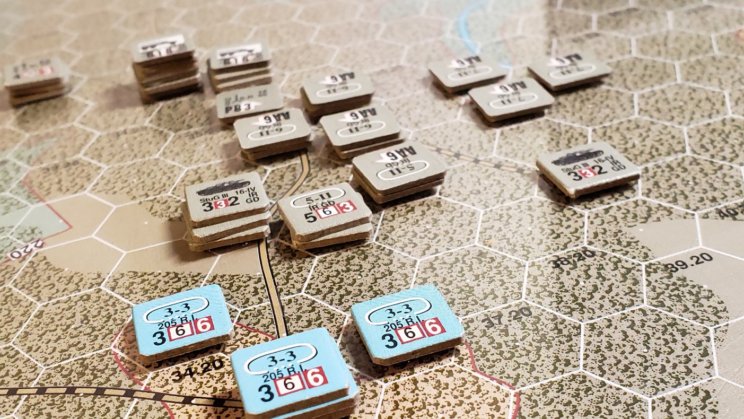
TCS was created by Dean Essig, who has many systems under his belt including BCS, OCS, SCS, and CWBS/RSS/LOB. TCS is currently at ruleset 4.02. There are 19 titles from 1989 to 2023. Though most of the TCS games involve WW2 battles there are games on the Korean and Falklands wars. Older titles are easy to find, inexpensive, and compatible with the current rule set with some easy adjustments like artillery supply.
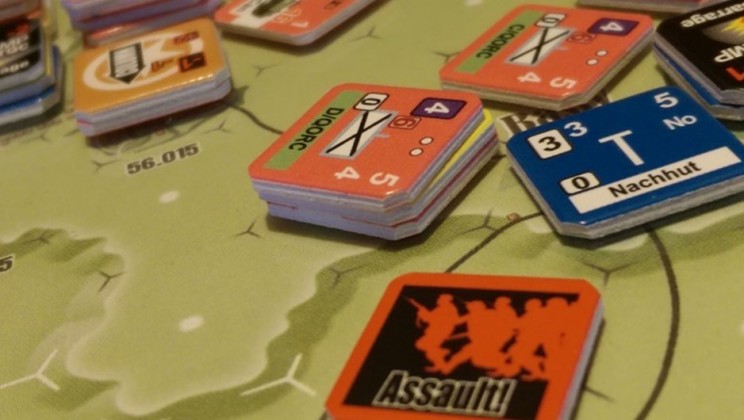
GTS was created by Adam Starkweather modifying a system from Victory Games in 1984 called Panzer Command by Eric Lee Smith (VG’s very successful Ambush and Civil War). Starkweather moved to Compass Games after the Greatest Day and a new ruleset called 2.0, and has since created a modified system at Compass called Company Scale System (CSS). GTS games were then designed by Joe Chacon with no change to ruleset 2.0. There are currently 7 games that go back from 2008 with aUtah coming out this year in 2024. Older titles are harder to find and can be quite expensive. The first three games with the 1.1 ruleset are not truly compatible with the current 2.0 series, and vice versa. I have tried using 2.0 for the earlier games – you need lots of house rules to make it work.
If you prefer one set of rules, improved over time, and backwards compatible – then TCS is the clear winner here
Unit Scale;
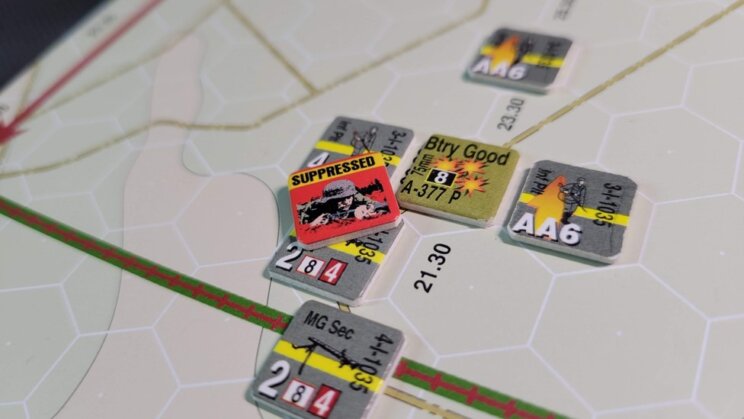
TCS is generally platoon level infantry and individual or small (section) groups of tanks/vehicles/support weapons. TCS breaks down an infantry battalion by infantry platoons from the separate support elements primarily of machine guns and mortars. Platoons are 5 steps, sections from 1-2 steps. Individual guns/afvs are 1 step, larger groups of vehicles can be up to 5 steps. Having served in a mechanized infantry battalion in the 1990s – this is the correct approach. Support elements “support” where needed, there are not blended in with the entire battalion.
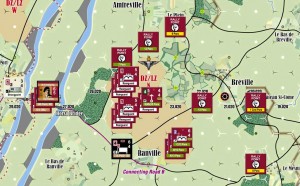
GTS is company sized infantry/AFV with platoon sized support weapons. Mortars are separated from the infantry companies, though sometimes they are kept with them in ruleset 2.0 (purple fire light mortar infantry). Full GTS companies have two steps, but smaller units are 1 and even zero. These are usually platoons or sections.
In terms of any advantage, I would say TCS’s scale of units is easier to work with. The company scale appears to be a difficult one to emulate, and likely why I can’t find many comparable games. Separating the machine gun support elements from the platoons also gives you a bit more flexibility. Also having smaller groups of vehicles enables more manoeuvre tactics. You have the ability in TCS to move small groups of tanks to hit flanks and cause crossfires.
Time Scale;
TCS is 20 minute turns, and all units (provided they are not supressed or paralysed) can move/and or fire, with AFV’s also using impulses. AFVs can do more than other units. BINGO! This is key. They can move, fire, and move again. They are not just mobile more powerful infantry. They can fight at a “higher tempo” – a description from the TCS rulebook.

GTS has two hour turns with their chit pull and divisional/command/formation chits allowing some units to do more in one turn than others. It allows the player to prioritize some units at the expense of others, because there is usually never enough Command/Dispatch points to do everything. While I do like that approach, it allows for gamey situations where some formations do too much, while others stagnate.
Hex Scale;
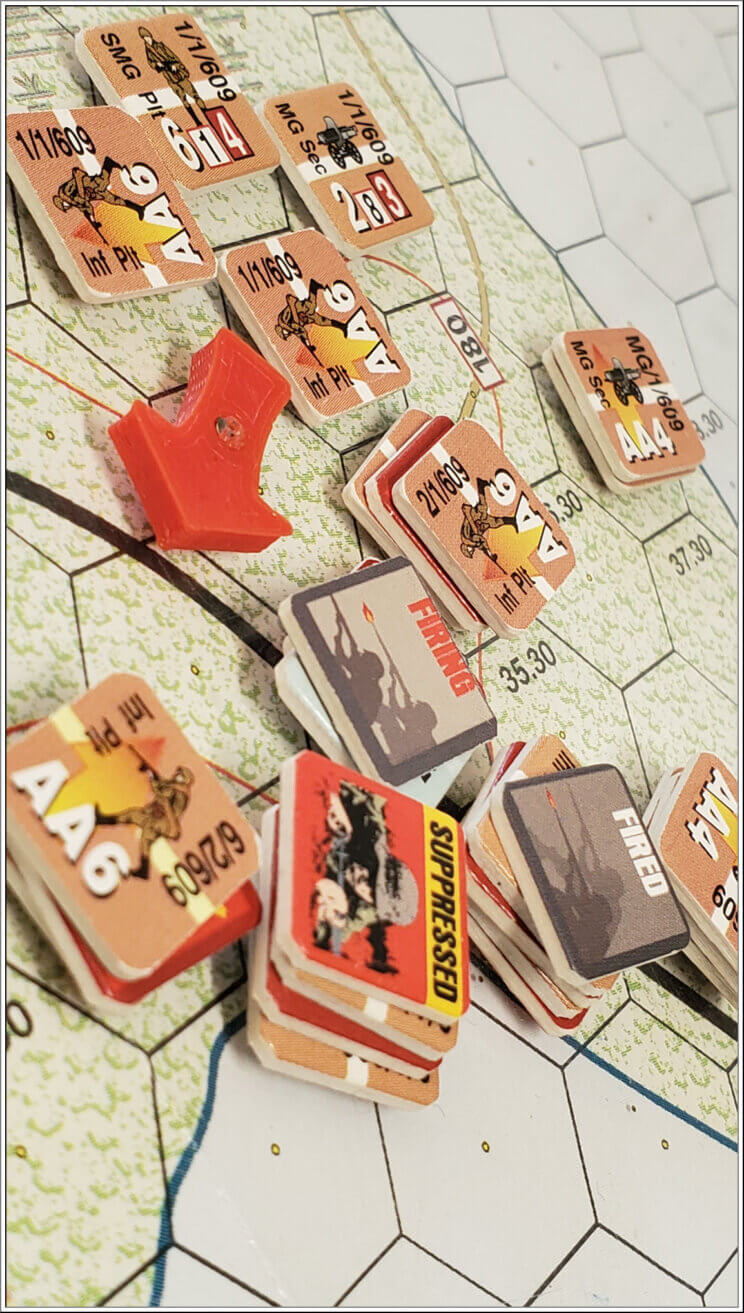
TCS is 125yds with 20m contour intervals. Infantry platoons can fire up to 4 hexes, which is 500m, but their fire is most effective within 1 hex. Beyond 2 hexes, 250yds, it really can’t do much more than cause a morale check.
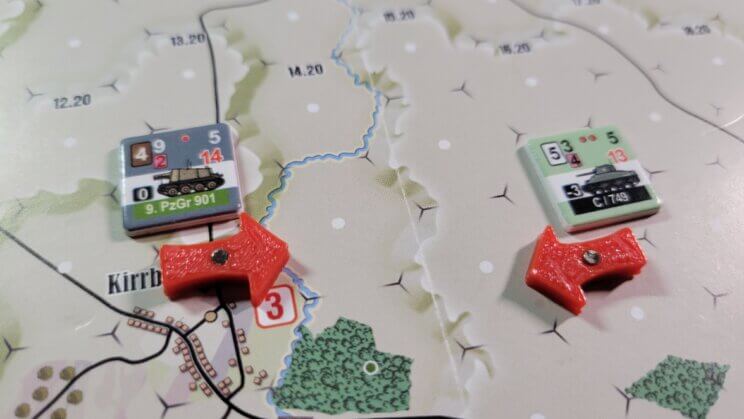
GTS is 500m per hex without contour intervals, though some games have crests or slopes. Infantry can only fire into adjacent hexes in GTS. And thus calling this a tactical game is a stretch. Normal infantry fire (up to light machine guns) is barely effective and rarely used at 500m but GTS treats small arms fire as the same whether its 100m or 500m. The one hex firing range of GTS for infantry presents a problem for me because it puts the units within assault range too quickly from their first ability to use small arms fire. In the GTS game Operation Mercury, where there is little armor and not a lot of artillery, this means that infantry basically gets to move freely around other enemy infantry until they get adjacent. The hex scale of GTS limits what the infantry can do, of which there is no fix. Infantry tactics in TCS is a big part of the game, and fun. In GTS the infantry companies just close in and then slog it out by attrition or assaults. Big advantage to TCS here. And if I can sum up the #1 issue I have with GTS is the scale is wrong, or unworkable. At the very lease it is problematic. It is trying to be both a tactical game, and an operational game, and it does neither well because of the scale it chose.
Counters/Map Art;
This is an easy one because the counter and map art of GTS is a solid A. It would get an A+ but the use of German symbols on their counters requires some getting used to . I love the “soft” hex grid and centre dots for terrain. Current TCS counters and maps are quite good, but the older titles are showing their age. I think the physical attractiveness of the GTS games attracts a lot of collectors and keeps the used game prices quite high. I have to admit selling some of my GTS games was hard because damn the components are just such works of art.
To Chit Pull or Not;
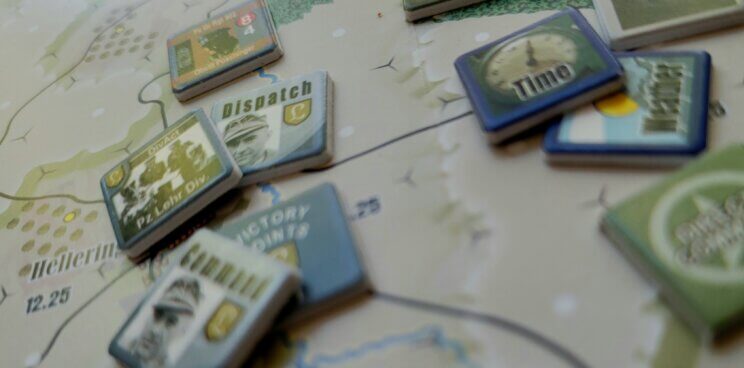
TCS is conventional I go/you go, but GTS is a Chit Pull game with a currency called Dispatch Points (buys chits) and Command Points (buys individual actions). I believe the chit pull method of GTS attracts a lot of people, it did for me, however it is not without its challenges. Chit pull games generally make it harder to execute a plan. Which works well for Civil war era games where command/control was so difficult. In GTS though it frustrates almost every attempt to co-ordinate your turn.
IMHO the chit pull/points system of GTS needs more tweaking because it leaves the door open to gamey tactics. The best example is that you can get more dispatch points in GTS by conserving them or converting command points in the 2.0 rules. This has the affect of players starting games off slowly on purpose to boost their dispatch points to the max. Players that burn through their points early on will always be struggling to catch up. A simple fix would be to make it less likely to get new dispatch points with a higher saved total. Which is the opposite right now. I can’t think of any other chit pull game where players will potentially get more chits if they do less.
Command/Control;
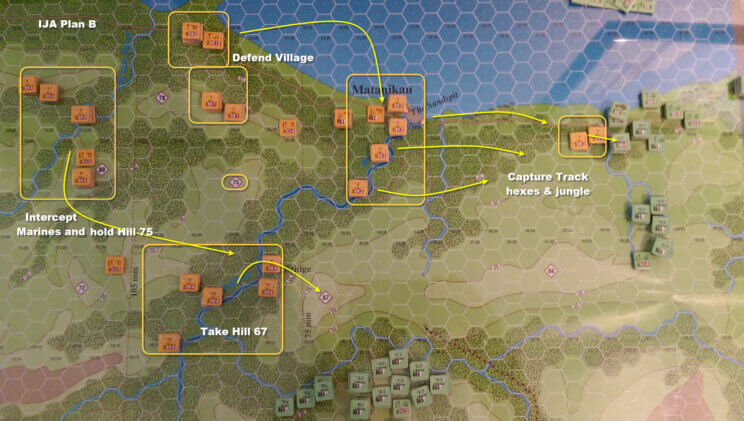
TCS has no leader units. Command is done via OP sheets, like the civil war orders systems Dean Essig produced with CWBS and LOB. But the big difference is here is that there is a more modern ability to change orders quickly as the battle unfolds – which considers modern radios and professional staffs. It takes some getting used to, but it prevents players from acting with that god-like ability in most other games.
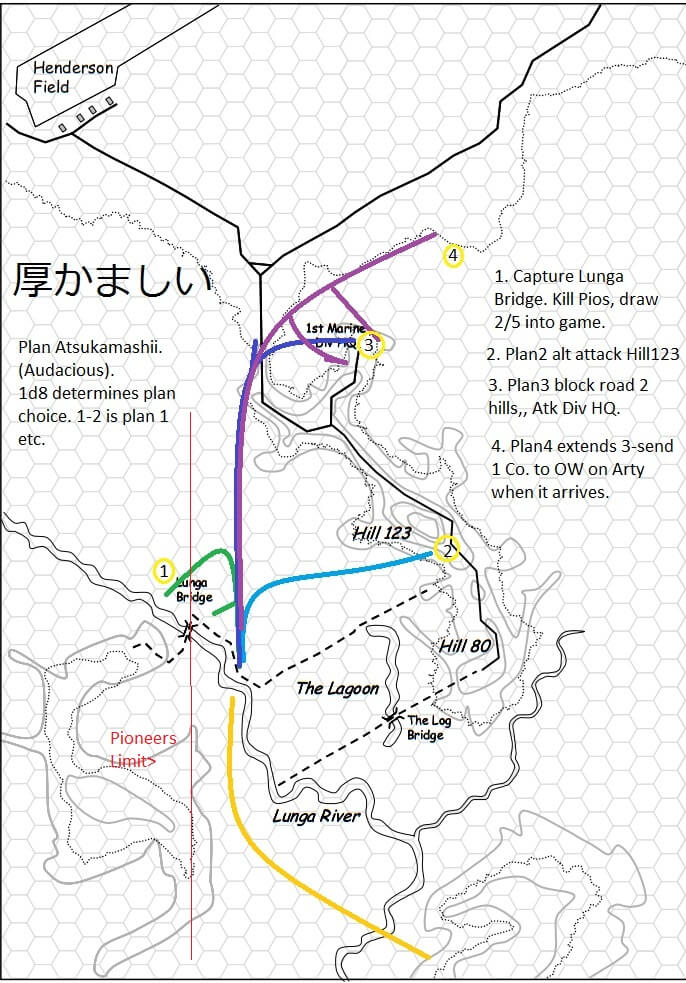
GTS does not have orders, but command/control is done with leader counters and Dispatch/Command points and throws in randomness with rolls for leader type actions. Players can prioritize formations/divisions/individual units, and the command and dispatch point ratings on formations are set by scenarios/games to reflect HQs that either performed better historically or had the means to. But as hinted upon previously – in can create some roller coaster rides and there are gamey ways to work around that.
While there are some nice features of GTS’s command system, TSC’s system gives you a more consistent flow to a game. TCS forces you to plan and stick to it (for the most part). With GTS you can plan all you want, but you need to have the chit sequencing to do it. How much do you like randomness in your games?
LOS and Spotting;
GTS has conventional 2D line of sight and there is only spotting with Artillery – which need a “spotter” to fire but it’s a simple LOS check with visibility. TCS uses both 3D LOS and spotting, and this is where the system really shines. Different targets have different spotting ranges. Where they are and what they are doing also matters. Love it! Dug in infantry in a protective urban environment who are not firing are practically invisible beyond assault range. Vehicles, especially if moving, are usually only limited by the visibility/los determined by the weather and time of day. TCS is a clear winner here. Not just against GTS but all other games and systems that claim to be tactical. Vehicles advancing towards AT guns or infantry will be hard pressed to fire on them effectively first – because they won’t see them. You can still fire into an area you “think” has enemy, called an unspotted area fire, but it is penalized. I think this is both realistic and quite fun to play out. How am I going to fire on that AT gun ahead, but I can’t spot him till I get closer? Someone must move up. Who? Do I have smoke to cover them? No smoke – darn. Ok then should I risk having them being hit when they advance closer? Ok will advance one hex and see if they open up and expose themselves. These questions/challenges and the anxiety hit you every turn in TCS. Eventually as an attacker you are forced to risk a bit of blood if you want to take that position. Such is war, there is a reason the 3:1 odds is seen as the minimum to any attack. The challenges of spotting enemy units are a foundational element in TCS games, and it’s a lot of fun.
Combat/CRT;
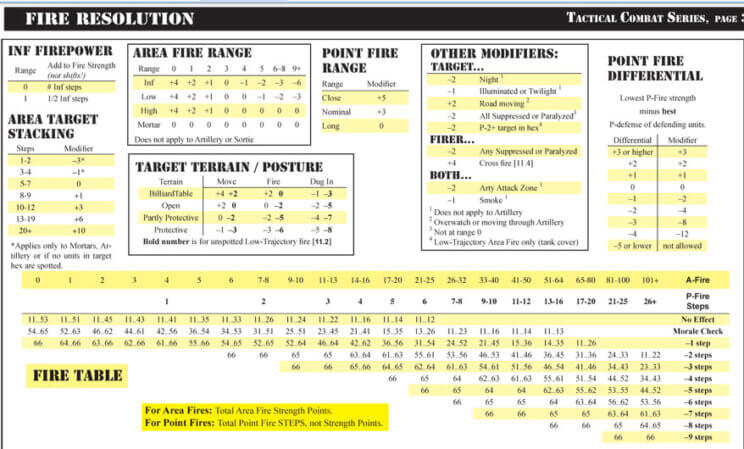
TCS uses a two die 11-66 model with common, normal adjustments for range/terrain, and things like smoke/arty, cross fire, whether the target is spotted – lots of things can change your chances. However, where they deviate from other games is the adjustments shift the column of fire, not the die roll. I had no problems learning it, and it memorizing most of the adjustments. It also has that unique crossfire adjustment that I have not seen in other games. Results include moral checks or step losses and morale checks. Moral checks can result in suppression, paralysis, forced retreats, or a surrender. With practice it becomes very easy to use and goes fast, you can roll 4 dice to get results for both the fire table and moral check in one shot.
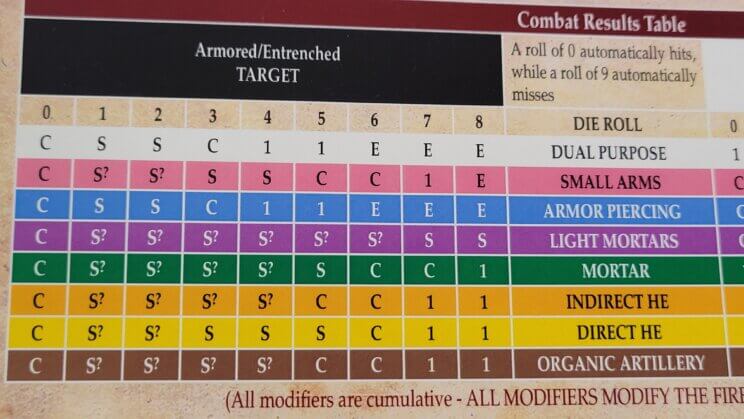
GTS uses a two page CRT on 1d10 that matches the weapon being fired with a target that is armored/entrenched vs all others. Instead of modifying the roll though, you modify the fire rating of the attacker. And if that seems hard to explain, its because its hard to understand why they chose to do it that way. It’s a gimmick, and it is flawed. Results are suppression, step loss, elimination, or something called a cohesion hit.
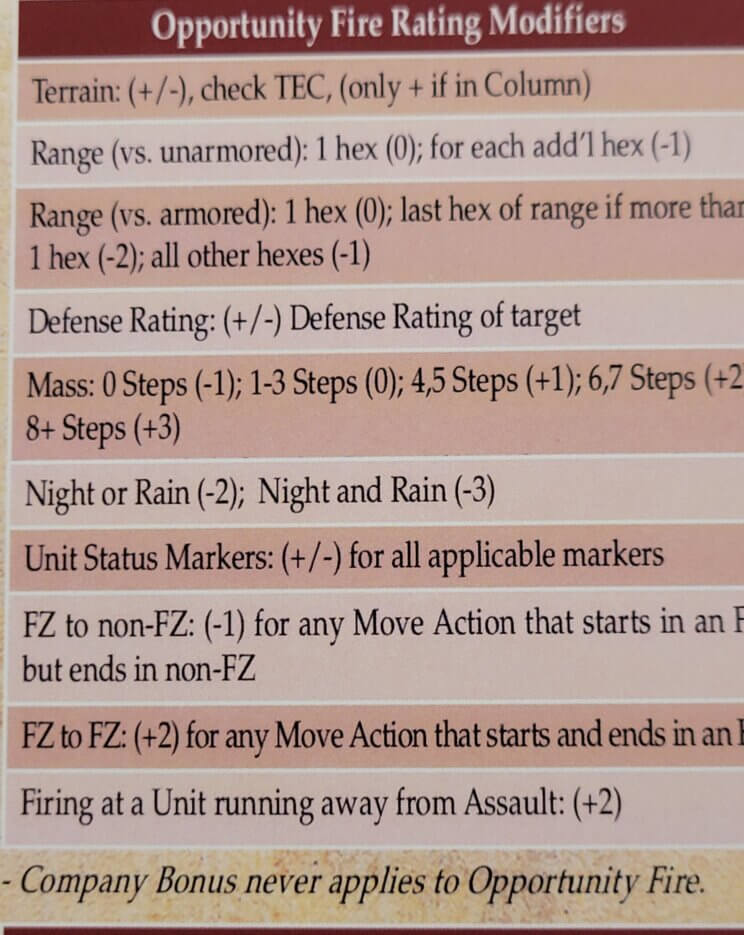
Suppression and step losses/elimination are not much different than TCS or other games. But the cohesion hit is a bit of a mysterious bird. You can convert suppression to a cohesion hit with a troop quality check (like a morale check). Multiple cohesion hits result in step losses, and cohesion can be removed by resting a unit away from the action. You can also get a cohesion hit by failing a forced march roll. Thus, cohesion seems to be a cross between actual casualties that can eventually become a step loss, and a way to simulate confusion and or fatigue. I don’t think mixing these two different things works.
The CRT in GTS is also not linear. All zeroes hit, all nines miss. Severity of hits doesn’t necessarily scale up or down the charts. And the use of modifiers is not consistent with this approach. For example, if a mortar with a fire rating of 4 fires against an elite target (-1 defensive rating) in excellent defensive terrain like a city (-3 terrain modifier), their fire rating becomes a 0. But if a zero is rolled on 1d10 it causes a 1 step loss. All other rolls are a miss. That same mortar firing on that same unit in a village (-1 terrain modifier) has a fire rating of 2. It still gets that 1 step loss on a roll of zero, a possible suppression hit on a 1, and a suppression hit on a 2. The “odds” of getting a result has increased, but it doesn’t make the fire more lethal at all. This part of the CRT has the affect of “bowling for zeroes”, in that any shot, no matter how many modifications reduce the fire rating, still has a chance of a hit on a roll of zero. What seems quite crazy to me is on the 1.1 rules for unarmored target side of the CRT there are 4 types of fire (of all the 6 possible) that the zero roll is a 1 step loss hit.
Many players have complained about bowling for zeroes but nothing has been done. The failure to not address what is such an easy fix, and overwhelming the majority opinion among all players, is telling.
The advantage on CRT, which is a bit part of any wargame, clearly lies with TCS here. GTS’s fire rating modifiers and CRT is frankly a hot mess. I can’t water down this critique. Adam Starkweather’s current CSS games (which appear to be a streamlined version of GTS) has a drastically different CRT. That says it all.
Opportunity Fire/Overshoot.
TCS’s op fire allows only one stack of units to fire into a hex moved into by an attacker, and if it’s a vehicle moving in an impulse that stack can only fire on it once per impulse. And it allows counter fire on that opportunity fire. This ability to fire back onto the unit doing op fire gives the defender some pause to ensure its worth it to take the shot.
In GTS only one unit can fire op fire, though they can fire an unlimited amount as long as the defender keeps on moving in front of it. Furthermore, there is no return fire. There is no disadvantage to using OP fire in GTS and thus a moving attacker faces the bad result of getting fire as it moves, and with no ability to have your units fire back. It forces the attacker to either risk damage or spend lots of effort supressing a target before moving. You still want to try and supress before in TCS, but you can have units in “overwatch”. They are set up waiting to fire on the enemy if they open up as your buddies move up. In the GTS two hour turn this could result in any effort to take ground dragging out throughout the day, because suppression is never a gimme. TCS is the clear winner here, because it gives the ability for an attacker to conduct overshoot to counter op fire. It more accurately depicts combat on a tactical level and its an exciting part of the game. As a former machine gunner one of our jobs was to move into a covered and concealed position to conduct overwatch. When you see the light of the enemy guns as they opened on the advancing platoon you start firing and put them down, or put their heads down.
Tanks Should Identify as Tanks, not Infantry
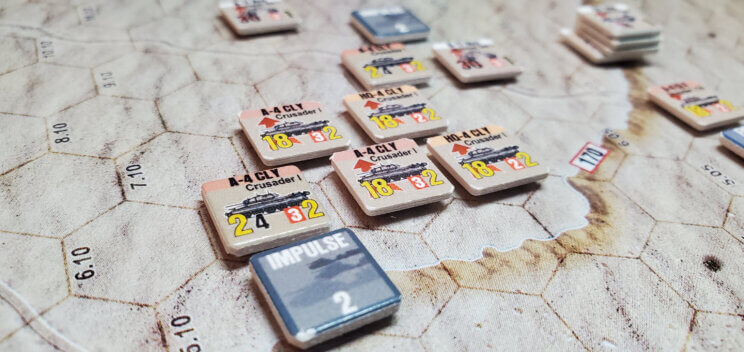
Do tanks act like tanks? Dean Essig thinks tanks act differently from other units. BCS and TCS are his best works for highlighting the differences. TCS tanks use point fire against other tanks, which is different from firing on infantry with area fire (usually less lethal, more suppressive in nature). The vehicle impulses in TCS are a simple but brilliant change from the original ruleset. GTS is a more conventional wargame in that tanks are just more powerful infantry. Higher attack values, higher defensive rating, more movement points. Since I learned BCS I have signed off on Essig’s take on tanks. I would love to hear some armored guys chime in on what they think.
The King of the Battle is….
Artillery! It caused more casualties than anything else in WW2. It’s a hard pill to swallow as an ex infantry man, but I don’t disagree. While you still need that grunt to step out of the wood line and take that 1×1 piece of dirt for King or country – arty usually decides the event.
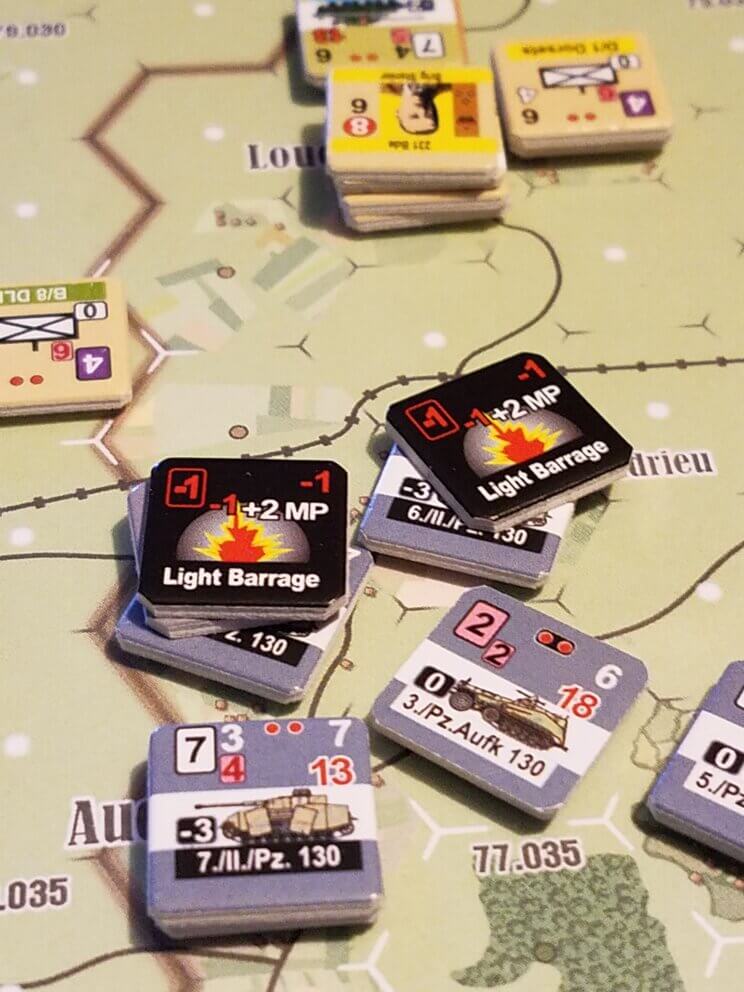
TCS and GTS both have on map and off map artillery. The artillery parks in GTS are a bit convoluted but I do enjoy the spotting and radio call method it uses. TCS divides artillery use in a separate phase from normal movement/combat and has a roll that roughly simulates the radio with GTS, in that there can be a no shoot. GTS does not use scatter as a possibility (that’s a fail imho). But the biggest problem I have with GTS and artillery is that the barrage can only affect one unit in the hex. That seems completely counter intuitive. Further having more steps in a hex makes it easier to hit that specific target. WHAT???
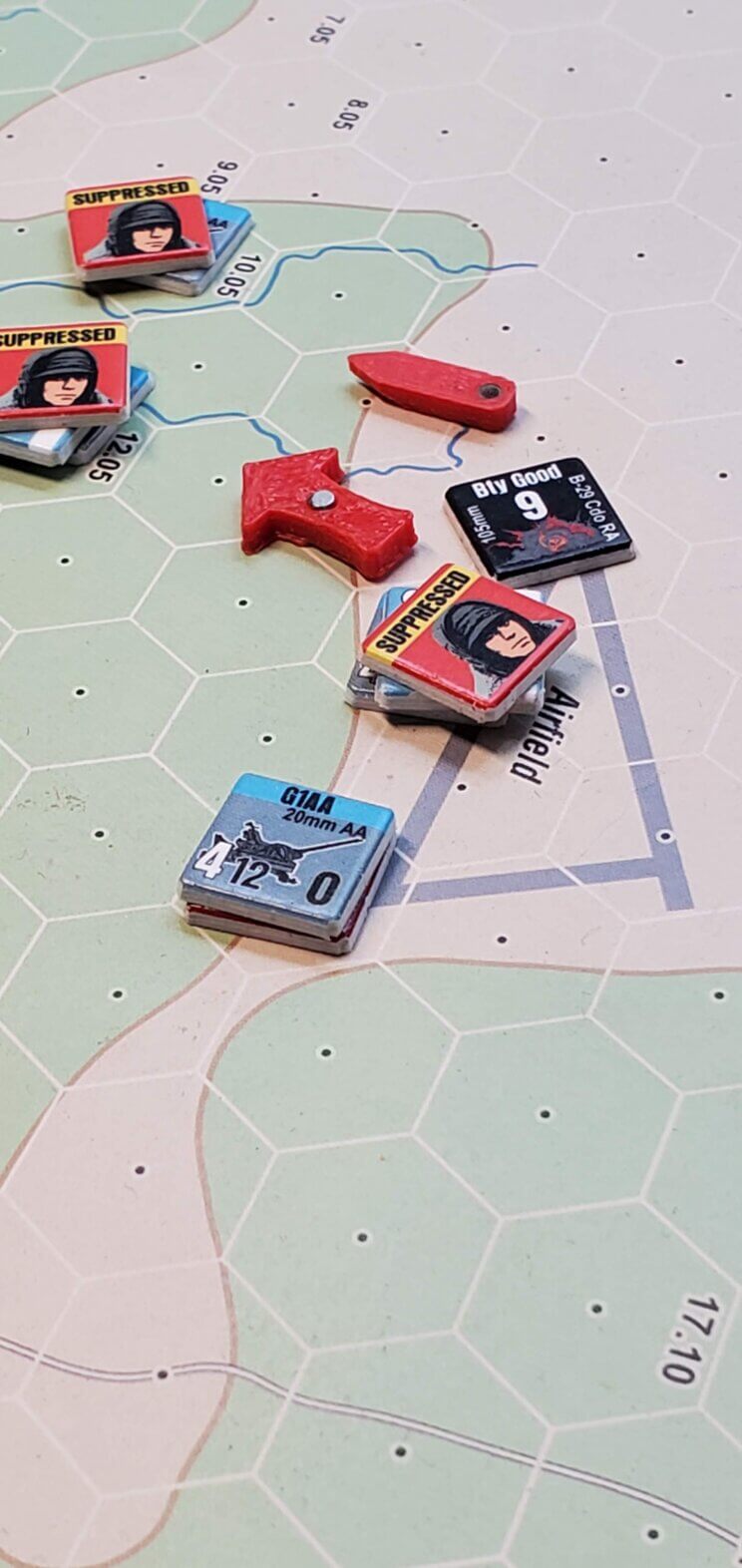
Also, because the TCS crt requires a moral check with a step loss, there is a high chance is an arty mission causes a step loss the stack of counters will suffer some kind of morale issue – suppression, paralysis, retreat, even surrender. GTS has none of that, you only get one result on an arty mission. If your company lost half its strength in one barrage -it’s not supressed. That goes back to the GTS crt being flawed, especially with regards to what artillery does.
CHARGE!!!
Assaults. If you think by now I have chosen a clear winner in these two systems, well there is more to pile on in favor of TCS. Now there are some similarities with both games. Defenders have a chance to conduct opportunity fire before the assaulters enter the hex for close combat. But assaults in GTS are a complicated procedure that changed quite a bit from the two rulesets. There is a lot of rolling and the designers put a flow chart in the rules to help explain it. I believe if you need a flow chart to explain rules you should rethink those rules! I prefer the earlier 1.1 ruleset for assaults, because in the newest version a unit must test for bravery more frequently. Thus, just conducting the assault becomes a risk, in that you could use up a valuable part of your unit’s turn with the attempted aborted right away.
There are only 2-3 rounds of assault in GTS and then if the defender is still standing (usually the case unless they are much weaker at the start) the attacker is back to square one. TCS’s assaults are far superior in that either the defender or attacker is going to die or break (save yourself retreat). You keep on assaulting until that happens. Round after round, until it’s settled. The removal of suppression from the defender on the initial charge in TCS is a neat element. Both units firing at the same time is my preference, but TCS does change that up when one side is supressed/paralyzed, and the other is not. I really like the TCS assaults. I look forward to conducting them. In GTS it was the least favorite part of combat for me.
Miscellaneous Elements
Retreats. TCS has forced retreats resulting from fire or assaults, or vehicle overruns. There are no retreats in GTS. That is another fail for me with GTS. Edge TCS.
Surrender. TCS units can surrender when morale is poor and the enemy fire is strong enough. Surrenders in GTS happen only by random event. Again – IMHO too much randomness is a bad thing. Edge TCS.
Morale. TCS is heavily invested in morale. In most games morale usually breaks before the dead pile gets too large, and that seems to line up quite closely to reality. There is no morale in GTS. Units have a troop quality but it’s more their ability to do things, and to withstand fire. Casualties piling up has no affect on formations at all. Edge to TCS.
Conclusions
GTS is a fairly new unique system taken from a wargame produced in 1984. It should surprise no one that TCS is the better system. GTS has more interesting campaigns/battles and the artwork is top notch. But that is where it ends for me. TCS is a proven system that has been around a long time and has seen many games and players throughout the decades. It has been honed, refined. The designers listened to feedback from players. TCS is just more fun and feels right. By all means date GTS, take it for a ride, enjoy a dance or two, but you will likely marry TCS. That’s the keeper.
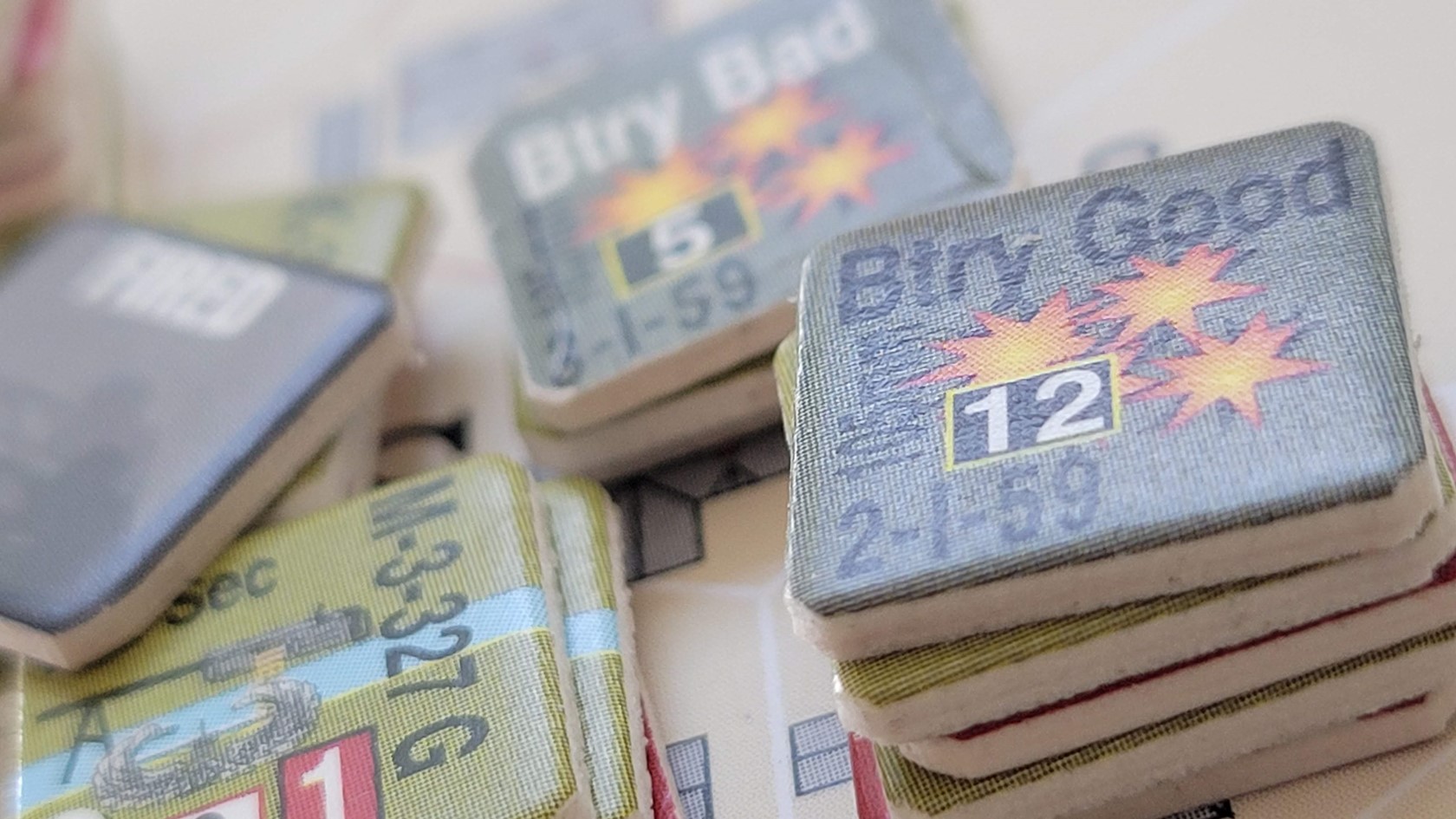
GTS is”wrong”?
But you still would date her. Are you saying that a guy who married them both is doing the “wrong” thing? I suggest you tighten up your prose.
adorable.
Thanks for sharing.
Good timing for the article in my case. I finally got to play GTS at the end of last year. Excited as I was before the start, I ended up finding it quite dull. Unexciting combat methods, little one could do with or around the different units. TCS, I have been playing this last month. I had them all a few years back but sadly sold them as I couldn’t find a willing opponent (I don’t play solo games). Just recently, I found a willing soul and we got underway with Goose Green. The combat is exciting what with fire, going to ground, retirement as an enemy closes etc etc and all in an intuitive makes sense way. Impressed with the experience so far and looking forward to a title with oodles of tanks and artillery next. One area for me that I think needs tightening is around the Op Sheets. I’m not into the ‘spirit of the game’ and ‘keep things fair on your own watch’. I’d have preferred a guideline with hard rules because quite frankly, in any walk of life including gaming, we all have our own parameters of what is fair and what is lax. Without a solid discussion beforehand and some hard set expectations thrashed out, I can see times when the Op Sheet lasitude can be abused.
Fantastic!
Op Sheets terms and detail need to be agreed. But also keep in mind in a real war sometimes orders were -‘ go take the hill’ and dudes adapted on the fly.
Thanks for this well-written post. I’ve been struggling with the decision to either learn or sell my GTS games. Dave helped me figure out what to do: sell. I own most of the TCS games but never learned to play. Another decision made – I ‘m keeping the games and learning to play ‘em. Thanks again!
You will not regret it. Join the TCS facebook page.
Also feel free to email me anytime with questions…. but answers are quicker on BGG or Facebook!
Now we just need an article comparing GTS, CSS, and TCS.
CSS is essentially GTS with the Assault rules cleaned up a bit.
Thank you very much for this article! Really helped understand the difference between these two systems before having played either. I just ended up getting Goose Green and will give the TCS system a try!
Yeah I agree TCS is really, really, really good. I prefer the first version of the series rules from 1988 or so. They flow much more logically to me and more clearly separate fire and movement.
TCS does have leader chits at times btw. Namely in Goose Green the Paras get their famous commander on his own chit.
Are you on BGG man?